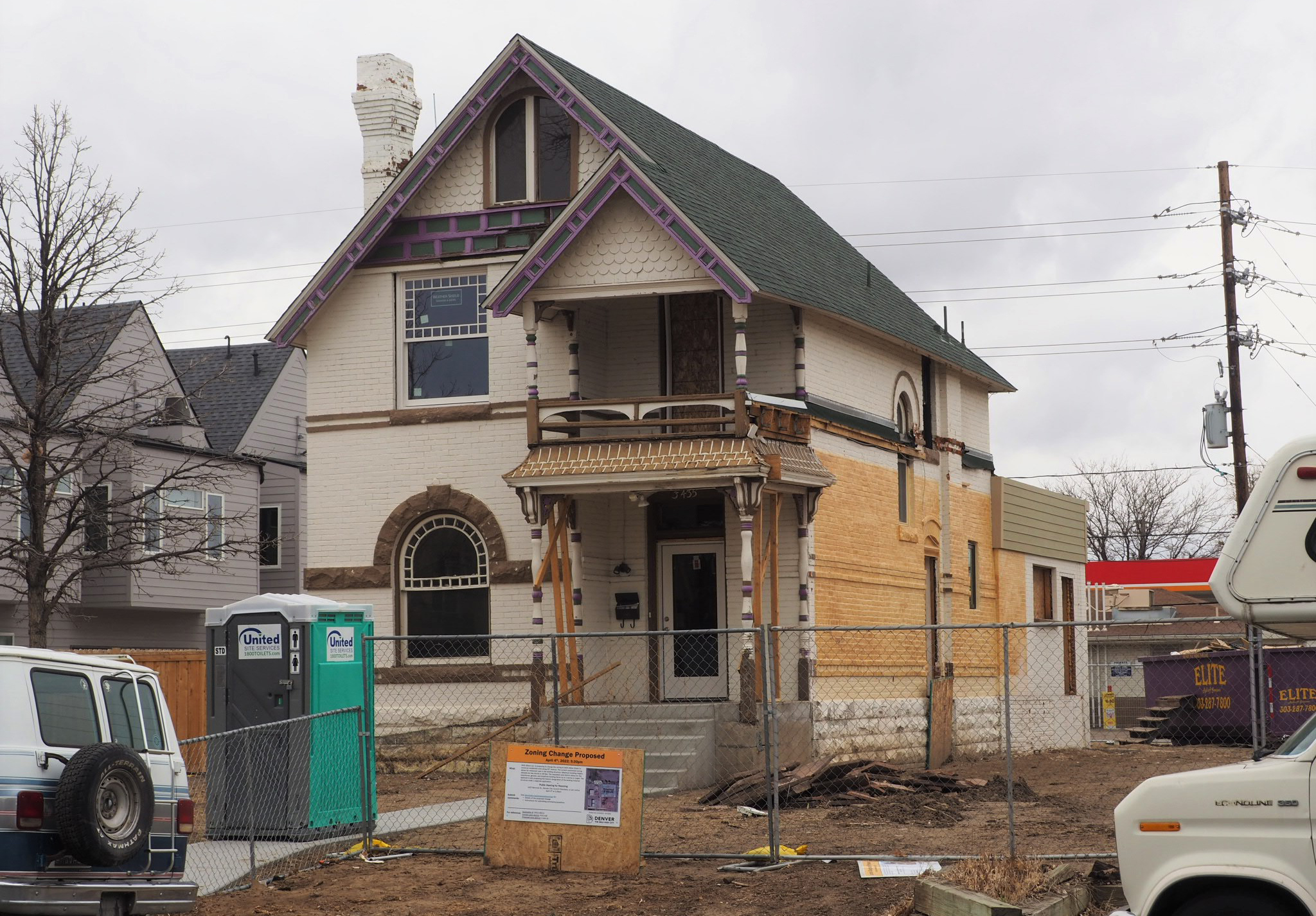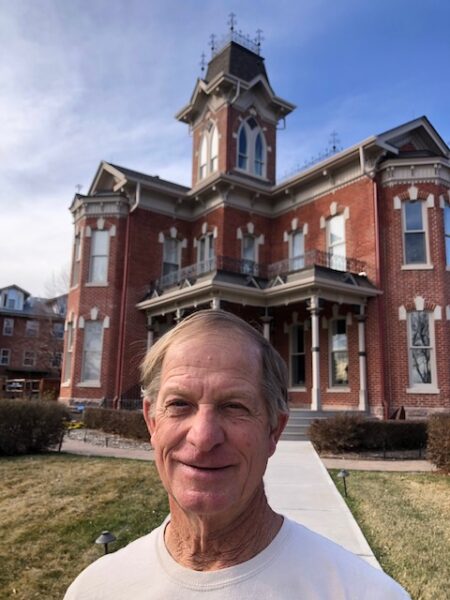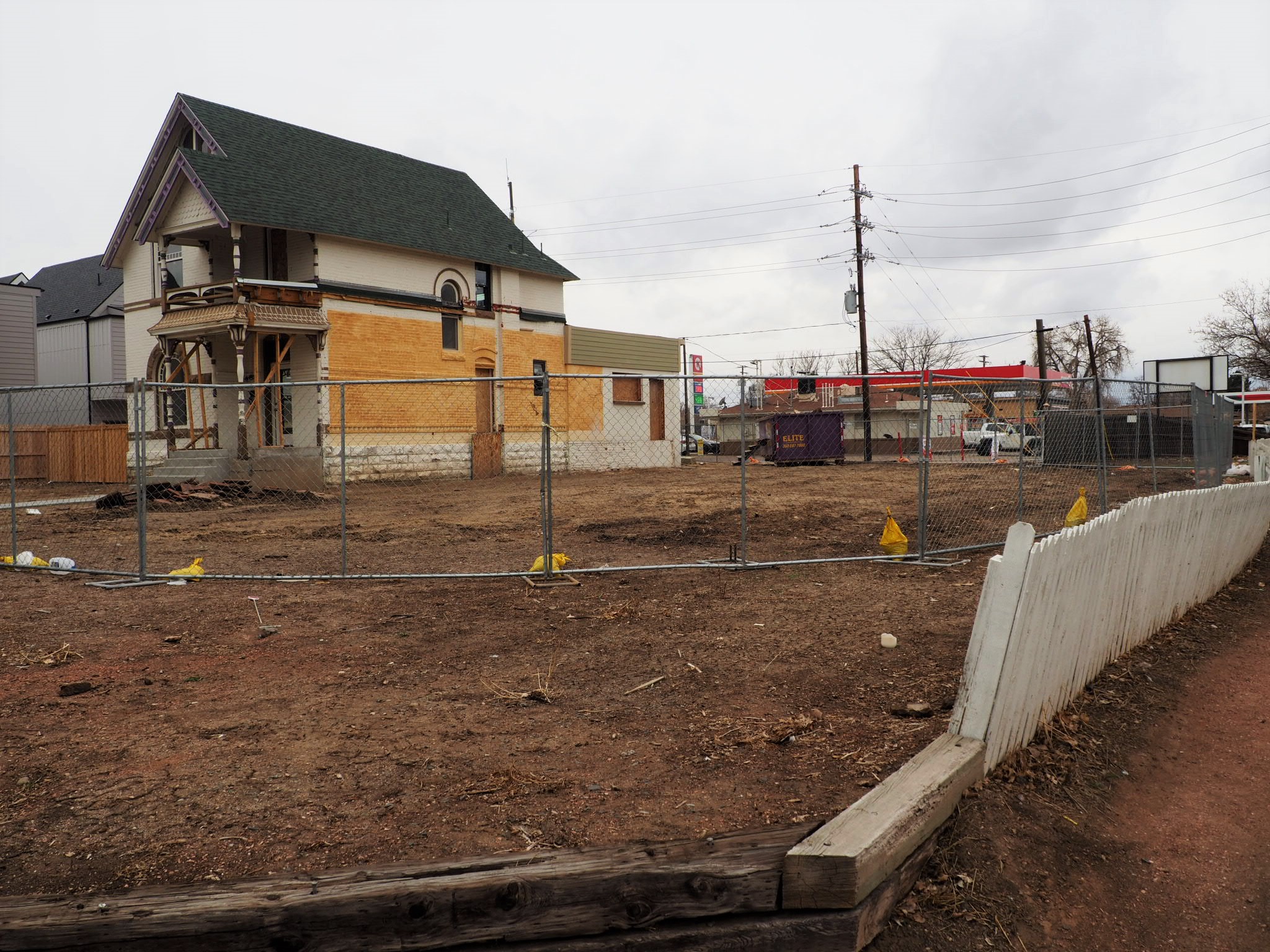
The Robinson house, at 3435 Albion St., dates to 1889. The Park Hill home is slated to become a city landmark. (Thomas Gounley photos)
One of the oldest homes in Denver’s Park Hill neighborhood, previously eyed for possible demolition, is now slated to become a city landmark.
A Denver City Council committee on Tuesday forwarded a landmark application for the Queen Anne home at 3435 Albion St. to the full body for consideration. Separately, the council is set to vote next week on a rezoning of the property.
The structure across from the former Park Hill Golf Course dates to 1889, and is known as the Robinson house, after original owner Jay Robinson, according to a report produced by city staff last year.
The building was intended to be the start of a new neighborhood, but a subsequent decline in the regional and national economy — think the Panic of 1893 — caused few new homes to be built nearby for years, according to the preservation-minded nonprofit Historic Denver.
“When it was built, there was nothing else around it,” Historic Denver Executive Director Annie Levinsky said.
In recent years, the building has been home to a restaurant — first Kate’s Restaurant from 1983 to 2011, then The Garden until 2017.
In March 2021, records show, the then-owner of the property applied to the city for a certificate of demolition eligibility for the property, which if issued would make it easy to demolish the structure within five years. At the time, the owner was under contract to sell the property to a buyer who was considering doing that, Levinsky said.
Levinsky said the owner’s agent told Historic Denver that they would be willing to accept another offer if the organization could find someone who would match or exceed the existing one.
That someone ended up being Steven Davis, who records show paid $840,000 for the property last June.
“If there’s an old house that’s kind of dilapidated and they’re interested, I’m on their call list,” he said of Historic Denver.
Through his company Davis Investments, Davis said he generally builds or renovates seven or eight homes in Denver a year. This is the third time that he has purchased and requested landmark status for a home in the city. He also renovated and now lives in a city landmark, the Bosler house at 3209 W. Fairview Place in the Highlands, although that one was already a landmark when he bought it.

Davis in front of the Bosler house, a city landmark that he renovated and lives in. (Courtesy of Steven Davis)
City landmark status makes it difficult, although not impossible, to demolish a structure in the future. It affords much more protection than the more recognizable National Register of Historic Places. The Robinson house is already on the national register.
The Robinson house sits on a 14,180-square-foot lot at the corner of Albion Street and 35th Avenue. Davis said he recently demolished an addition that was built onto the home to the north at one point, leaving the original structure. That has created space for an additional structure along 35th Avenue.
“I’m trying to get a five-plex or townhomes on that lot,” Davis said, noting that he still needs to get specific development plans approved by the city.
The Robinson house itself is in rough shape and needs significant renovations. Since The Garden closed, the building has been vacant — but not entirely.
“It was occupied by homeless folks … They had torn out all the fixtures. Anything of any value was out of the house,” Davis said, adding that the vandalism at one point caused the house to flood.
Davis said he also has to do significant work because he’s seeking to change the building’s use from restaurant back to residential, which means he’s required to bring every component of the structure up to city code.
“I would say it’s going to take up to $300,000 to get that property in ship-shape condition,” he said. “Probably 30 to 40 percent more than what I thought it would be.”
Davis said he hasn’t decided whether he will rent out or sell the home once it’s fixed up.
“I am always for showing that these properties don’t have to be scraped,” he said. “Hopefully, it will be a successful venture.”
In the wake of recent well-publicized feuds over structures such as Tom’s Diner and the Denver7 building, Levinsky said the process shows keeping old structures around doesn’t need to be a contentious process.
“Historic preservation and new housing and new development can go hand-in-hand,” she said.

The Robinson house, at 3435 Albion St., dates to 1889. The Park Hill home is slated to become a city landmark. (Thomas Gounley photos)
One of the oldest homes in Denver’s Park Hill neighborhood, previously eyed for possible demolition, is now slated to become a city landmark.
A Denver City Council committee on Tuesday forwarded a landmark application for the Queen Anne home at 3435 Albion St. to the full body for consideration. Separately, the council is set to vote next week on a rezoning of the property.
The structure across from the former Park Hill Golf Course dates to 1889, and is known as the Robinson house, after original owner Jay Robinson, according to a report produced by city staff last year.
The building was intended to be the start of a new neighborhood, but a subsequent decline in the regional and national economy — think the Panic of 1893 — caused few new homes to be built nearby for years, according to the preservation-minded nonprofit Historic Denver.
“When it was built, there was nothing else around it,” Historic Denver Executive Director Annie Levinsky said.
In recent years, the building has been home to a restaurant — first Kate’s Restaurant from 1983 to 2011, then The Garden until 2017.
In March 2021, records show, the then-owner of the property applied to the city for a certificate of demolition eligibility for the property, which if issued would make it easy to demolish the structure within five years. At the time, the owner was under contract to sell the property to a buyer who was considering doing that, Levinsky said.
Levinsky said the owner’s agent told Historic Denver that they would be willing to accept another offer if the organization could find someone who would match or exceed the existing one.
That someone ended up being Steven Davis, who records show paid $840,000 for the property last June.
“If there’s an old house that’s kind of dilapidated and they’re interested, I’m on their call list,” he said of Historic Denver.
Through his company Davis Investments, Davis said he generally builds or renovates seven or eight homes in Denver a year. This is the third time that he has purchased and requested landmark status for a home in the city. He also renovated and now lives in a city landmark, the Bosler house at 3209 W. Fairview Place in the Highlands, although that one was already a landmark when he bought it.

Davis in front of the Bosler house, a city landmark that he renovated and lives in. (Courtesy of Steven Davis)
City landmark status makes it difficult, although not impossible, to demolish a structure in the future. It affords much more protection than the more recognizable National Register of Historic Places. The Robinson house is already on the national register.
The Robinson house sits on a 14,180-square-foot lot at the corner of Albion Street and 35th Avenue. Davis said he recently demolished an addition that was built onto the home to the north at one point, leaving the original structure. That has created space for an additional structure along 35th Avenue.
“I’m trying to get a five-plex or townhomes on that lot,” Davis said, noting that he still needs to get specific development plans approved by the city.
The Robinson house itself is in rough shape and needs significant renovations. Since The Garden closed, the building has been vacant — but not entirely.
“It was occupied by homeless folks … They had torn out all the fixtures. Anything of any value was out of the house,” Davis said, adding that the vandalism at one point caused the house to flood.
Davis said he also has to do significant work because he’s seeking to change the building’s use from restaurant back to residential, which means he’s required to bring every component of the structure up to city code.
“I would say it’s going to take up to $300,000 to get that property in ship-shape condition,” he said. “Probably 30 to 40 percent more than what I thought it would be.”
Davis said he hasn’t decided whether he will rent out or sell the home once it’s fixed up.
“I am always for showing that these properties don’t have to be scraped,” he said. “Hopefully, it will be a successful venture.”
In the wake of recent well-publicized feuds over structures such as Tom’s Diner and the Denver7 building, Levinsky said the process shows keeping old structures around doesn’t need to be a contentious process.
“Historic preservation and new housing and new development can go hand-in-hand,” she said.

